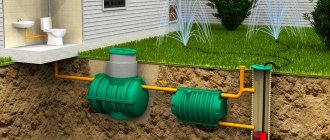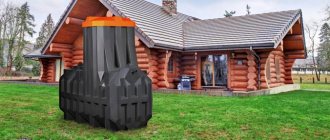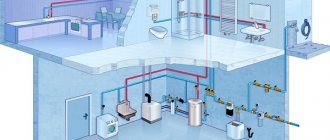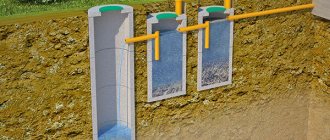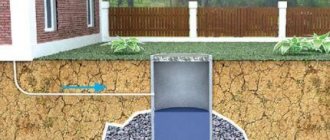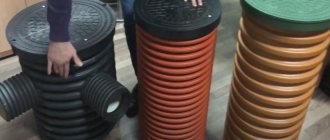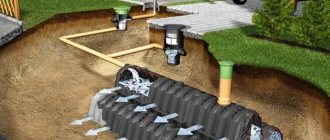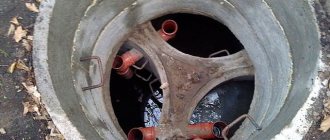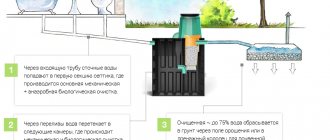Articles 02/12/2021
Many people live in country houses seasonally and most often only in the summer. In this case, you need to take care of preserving the septic tank for the winter. This procedure is required in order to prepare the operating waste disposal unit for the complete absence of sewage and a decrease in temperature, which is usually observed from October to April. Practical recommendations will help you prepare for the procedure in the best possible way.
The main purpose of conservation is to preserve the full functionality of the autonomous sewer system until the next season. This allows you to avoid breakdowns of expensive equipment and eliminate the death of aerobic bacteria that perform the function of processing fecal matter. A set of appropriate measures allows us to achieve our goals.
At what frequency of septic tank use is equipment conservation necessary?
In most cases, if you visit a country house once every two or three weeks, then preserving the septic tank for the winter with your own hands is not required. However, if you leave your property for a longer period, you will need to prepare the septic tank for winter. The bacteria that are inside the biological treatment plant need constant nutrition and new portions of wastewater. A significant break in such nutrition can lead to the death of microorganisms that perform the main function. In addition, when processing wastewater, bacteria generate significant heat, which provides additional protection for the waste disposal unit from cooling. Manufacturers provide instructions for each specific model of autonomous sewage system. The manufacturer's documentation usually contains conservation information for a given device. We will look at general principles and nuances that will help prepare treatment equipment for low temperatures.
Model selection principle
This type of treatment facility is selected based on its daily flow rate and the magnitude of the salvo discharge. You calculate your daily consumption based on the number of residents and all the procedures they undergo every day.
For example. Family of 3, there is a washing machine, dishwasher, shower/bathtub, toilet, kitchen sink. We count how many times a cistern can be flushed on average per day, multiply by its capacity, and find how much water is flushed when the toilet is installed. Next, we calculate how much water is spent on laundry, washing dishes, washing, how often family members take a shower, bath, etc. We sum up all the data and get the number of drains per day.
Now we calculate the magnitude of the salvo discharge. This is the volume that an individual sewerage installation can process within 2 hours. Most often, at a minimum, this is the volume of two bathrooms or the amount of water that a family spends during an evening/morning shower + toilet flushes + water for washing + cooking + washing dishes. This is if all these processes occur simultaneously.
Knowing these two numbers, you select a model. In the selected model, both numbers should not be less. More - easily, less - the installation is unlikely to cope. As a rule, the main criterion is salvo discharge. Since if the installation cannot cope with such an amount of water, untreated water will leave the septic tank. As professionals say, there will be a removal of silt, and accordingly, a smell and accompanying “charms” will appear.
What you need to know about using a septic tank in winter
Autonomous sewerage must be placed underground at a certain depth, below the soil freezing level. Thanks to this, even during the cold period, the temperature in the heat exchanger will not drop below +5 degrees. This will prevent the death of aerobic bacteria and damage to treatment equipment. Modern models of septic tanks are made of polymer materials. The finished product is characterized by lightness, strength and reliability. Light weight greatly simplifies the process of delivering the cleaning unit. It will be much easier to install on site. However, this can also become a problem. When groundwater rises, the autonomous sewage system may float to the surface and rise slightly. Therefore, it is not recommended to completely drain the liquid from the reservoir. A properly installed septic tank and compliance with the above recommendations will prevent freezing of the autonomous sewage system even in winter. Due to the fact that there will always be water in the filtering equipment, any movement is excluded. The liquid present will allow you to maintain the required weight, which will help securely fix the structure even when groundwater rises.
The lineup
Tver septic tanks are available in different volumes for different amounts of waste. Each model has modifications that have a different letter designation:
The sizes, volume and price of some models of septic tanks in Tver are summarized in a table.
| Name/modifications | Productivity per day | Number of users | Dimensions (L*W*H) | Price | Salvo release |
| 0.35 P/0.35 PN | 350 l/day | up to 2 | 1.4*1.1*1.65 m | 938$/980$ | 100 l |
| 0.5 P | 500 l/day | until 3 | 1.65*1.1*1.67 m | 995$ | 150 l |
| 0.5 PN | 500 l/day | until 3 | 2*1.1*1.67 m | 1110$ | 150 l |
| 0.5 RM | 500 l/day | until 3 | 1.65*1.1*1.97 m | 1165$ | 150 l |
| 0.5 PNM | 500 l/day | until 3 | 2*1.1*1.97 m | 1285$ | 150 l |
| 0.75 P | 750 l/day | until 3 | 2.25*.086*1.67 m | 1150$ | 250 l |
| 0.75 PNM | 750 l/day | until 3 | 2.65*.086*1.97 m | 1550$ | 250 l |
| 0.75 NLNM | 750 l/day | until 3 | 3.05*.086*1.97 m | 1685$ | 250 l |
| 0.85 P | 850 l/day | up to 5 | 2.1*1.1*1.67 m | 1250$ | 280 l |
| 0.85 NP | 850 l/day | up to 5 | 2.1*1.1*1.67 m | 1385$ | 280 l |
| 0.85 NPN | 850 l/day | up to 5 | 2.5*1.1*1.67 m | 1540$ | 280 l |
| 1 Mon | 1000 l/day | from 3 to 5 | 3*1.1*1.67 m | 1780$ | 350 l |
| 1 PNM | 1000 l/day | from 3 to 5 | 3*1.1*1.97 m | 1805$ | 350 l |
| 1 NPNM | 1000 l/day | from 3 to 5 | 3.35*1.1*1.97 m | 1980$ | 350 l |
| 1.2 P | 1200 l/day | up to 5 | 2.88*1.1*1.67 m | 1555$ | 400 l |
| 1.2 RM | 1200 l/day | up to 5 | 2.8*1.1*1.97 m | 1790$ | 400 l |
| 1.2 NPM | 1200 l/day | up to 5 | 3.6*1.1*1.67 m | 1845$ | 400 l |
| 1.5 P | 1500 l/day | from 5 to 7 | 3.5*1.1*1.67 m | 1780$ | 500 l |
| 1.5 NPR | 1500 l/day | from 5 to 7 | 4.1*1.1*1.67 m | 2120$ | 500 l |
| 2 Mon | 2000 l/day | from 7 to 10 | 4.5*1.3*1.67 m | 2410$ | 650 l |
| 2 PNM | 2000 l/day | up to 12 | 4.5*1.3*1.67 m | 2570$ | 650 l |
| 3 P | 3000 l/day | up to 15 | 4*1.6*1.67 m | 2535$ | 800 l |
| 3 NPNM | 3000 l/day | up to 15 | 5*1.6*1.97 m | 3030$ | 800 l |
| 4 P | 4000 l/day | up to 20 | 4*1.3*1.67 m | 4190$ | 1200 l |
| 6 P | 6000 l/day | from 22 to 30 | 4*1.6*1.67 m | 5000$ | 2000 l |
Stages of conservation of a biological treatment plant in winter
- De-energizing equipment. The cleaning unit must be disconnected from the power supply system. Additionally, you need to disconnect the air filter and drain pump if one was used. Typically, all electrical appliances are located on top of the device, so they are quite easy to dismantle. All dismantled instruments and devices must be stored in a warm room.
- Removing solid sediment. The receiving chamber of the biological treatment station must be cleared of sediment. If this is not done, the sediment will begin to decompose. Subsequently, during operation in the spring, an unpleasant odor will appear and the liquid in the system will be cloudy.
- Flushing all components. The septic tank drain needs to be flushed before winter. In addition, it is necessary to rinse hoses, nozzles and other devices from dirt and waste residues. If the system has a built-in airlift or stabilizer, it also needs to be washed and cleaned.
- Checking the water level. Before turning off the septic tank in winter, you need to make sure that the treatment device is filled with water. The volume of liquid should be about 70% of the total volume of the tank. If there is not enough water, you need to add it.
- Insulation of the system. It is recommended to insulate the upper part of the waste disposal unit, which is located above the ground. In regions where the temperature drops to zero degrees in winter, there is no need to insulate it. If in winter the temperature drops below zero, then insulation is required. For these purposes, you can use polystyrene foam, expanded polystyrene, expanded clay and other thermal insulation materials. It is also important to insulate the cover of the unit; you can use an old blanket.
In addition, it is recommended to insulate the sewer pipes through which wastewater is discharged. Insulation must be carried out not only from above, but also over the entire surface of the sewer network. For this purpose, various insulating materials can be used. This is recommended for pipes that are located above the ground.
If the septic tank is already frozen, then you can use the following methods to defrost it:
- — Watering the sewer and septic tank with hot water. Hot water will defrost the ice if it has not yet become very thick.
- — You can make a special reagent at home from salt and baking soda. It is necessary to make such a solution highly concentrated so that the sewer system can be cleaned from the inside. This is the most effective and cheapest method of defrosting a septic tank.
- — Application of heating cables. This requires special devices and heating cables. These cables are wrapped around the perimeter of the septic tank and heated until the ice completely melts. However, this is a rather expensive method, the use of which also requires certain professional skills.
To avoid problems with the operation of the septic tank, it is necessary to use insulating agents at the design stage and then during installation, as well as maintain the correct installation depth. If it is not possible to carry out the installation work yourself, then it is best to contact a specialized company.
When is it necessary to preserve a septic tank?
In accordance with the manufacturers' recommendations, the septic tank must be prepared before the winter period, when the temperature is still above zero. Care must be taken to ensure that the recycler does not freeze. If there are doubts about the depth of freezing, you can protect the structure using a well-known folk method. A little sand is poured into plastic bottles and lowered to the bottom of the disposal, where the water is. This is how “floats” are formed. They are usually immersed half their height. They act as a counterweight. Bottles with sand protect the structure and walls of the chambers from the expansion of the ice crust and help prevent damage to the biological treatment station. Homemade septic tanks freeze quite often in winter. To avoid freezing of the treatment unit, it is recommended to use insulation. Basically, today, autonomous sewage systems are made of concrete rings and concrete poured into formwork. Various containers and reservoirs are widely used. Brickwork and stone are also used. In such cases, it is necessary to take care of insulating the part that protrudes outward, including sewer pipes. You can watch a video about septic tank maintenance in winter to get more information. In some cases, even an insulated disposal can freeze. In this case, you need to find out the true cause of freezing. Common causes include improper installation of the unit, poor system insulation and significant deficiencies in the treatment equipment system. In addition, poor sealing of the equipment can lead to the penetration of cold air into the system, and as a result, can cause freezing of the biorefinery station. There are various ways to revive an autonomous sewer system. Warming up with hot water is considered the most effective. To do this, you will need to fill all sinks and drains with hot water. Thanks to this, it will be possible to melt the ice in the pipes and system. Saline solutions can be used. But after this, it is definitely recommended to rinse everything with plain water, since saline solutions have a strong corrosive effect. You can also “warm up” the structure using a gun powered from an outlet. Much will depend on the degree of freezing of the biological treatment plant. It is best to consult with experienced specialists to avoid damage to the cleaning unit at the most inopportune time.
If you are planning to purchase cleaning equipment for your country house, then be sure to discuss the issue of protecting it from freezing in winter. It is advisable to discuss this with the design engineers in advance. To prevent freezing, many install a heating cable. Alternative options for heating the system in winter are also possible. Try to get more detailed information from the company managers or installers performing installation and maintenance.
How to avoid freezing sewer pipes.
If the slope is insufficient, the drainage will stagnate and freeze. With a large slope, deposits accumulate in the pipes, the useful diameter of the pipes is reduced, and a sewer blockage occurs. This will cause the pipes to freeze.
Rice. 11 The slope of the pipes depends on their diameter
Insulate pipes with foamed polyethylene
Energoflex, Thermoflex or Penofol.
It is more reliable to organize the drainage of water into a ditch or ravine by force using a pump.
When drained by gravity, water has a low speed and mass. The pump compartment accumulates mass, and the pump gives it energy.

